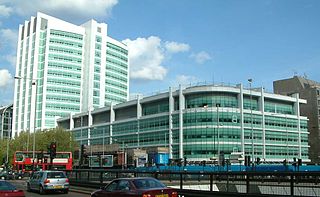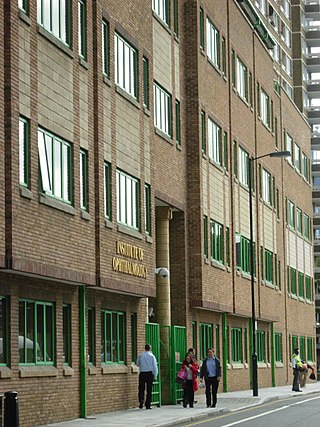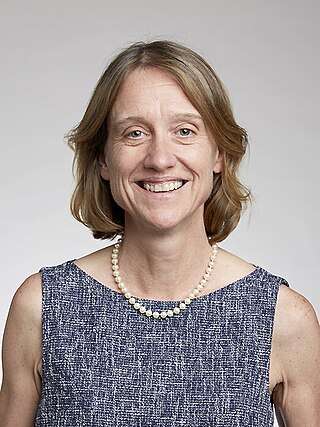
Biomedical engineering (BME) or medical engineering is the application of engineering principles and design concepts to medicine and biology for healthcare applications. BME is also traditionally logical sciences to advance health care treatment, including diagnosis, monitoring, and therapy. Also included under the scope of a biomedical engineer is the management of current medical equipment in hospitals while adhering to relevant industry standards. This involves procurement, routine testing, preventive maintenance, and making equipment recommendations, a role also known as a Biomedical Equipment Technician (BMET) or as a clinical engineer.

Health informatics is the study and implementation of computer structures and algorithms to improve communication, understanding, and management of medical information. It can be viewed as branch of engineering and applied science.
Cambridge University Hospitals NHS Foundation Trust is a British public sector healthcare provider located in Cambridge, England. It was established on 4 November 1992 as Addenbrooke's National Health Service Trust, and authorised as an NHS foundation trust under its current name on 1 July 2004.

Paul Rudd Drayson, Baron Drayson, is a British businessman, amateur racing driver and Labour politician. He was Minister of Science in the Department for Business, Innovation and Skills until May 2010, where he replaced Ian Pearson. In June 2009 he was additionally appointed as Minister of State for Strategic Defence Acquisition Reform at the Ministry of Defence. After losing his ministerial positions in the General Election 2010 he decided to devote himself totally towards his motorsports company Drayson Racing Technology. He is chairman and CEO of Drayson Technologies Ltd.

Ara Warkes Darzi, Baron Darzi of Denham, is an Armenian-British surgeon, academic, and politician.

John Radcliffe Hospital is a large tertiary teaching hospital in Oxford, England. It forms part of Oxford University Hospitals NHS Foundation Trust and is named after John Radcliffe, an 18th-century physician and Oxford University graduate, who endowed the Radcliffe Infirmary, the main hospital for Oxford from 1770 until 2007.
The National Institute for Health and Care Research (NIHR) is the British government's major funder of clinical, public health, social care and translational research. With a budget of over £1.2 billion in 2020–21, its mission is to "improve the health and wealth of the nation through research". The NIHR was established in 2006 under the government's Best Research for Best Health strategy, and is funded by the Department of Health and Social Care. As a research funder and research partner of the NHS, public health and social care, the NIHR complements the work of the Medical Research Council. NIHR focuses on translational research, clinical research and applied health and social care research.

The UCLH Biomedical Research Centre is a biomedical research centre based in London. It is a partnership between University College London Hospitals NHS Foundation Trust (UCLH), University College London (UCL) the National Institute for Health and Care Research (NIHR) and UCLPartners. It was one of the original five Comprehensive Biomedical Research Centres established by the NIHR in April 2007.

The UCL Institute of Ophthalmology is an institute within the Faculty of Brain Sciences of University College London (UCL) and is based in London, United Kingdom. The institute conducts research and post-graduate teaching in the area of ophthalmology.

Biomedical sciences are a set of sciences applying portions of natural science or formal science, or both, to develop knowledge, interventions, or technology that are of use in healthcare or public health. Such disciplines as medical microbiology, clinical virology, clinical epidemiology, genetic epidemiology, and biomedical engineering are medical sciences. In explaining physiological mechanisms operating in pathological processes, however, pathophysiology can be regarded as basic science.
Mark G. Allen is a professor specializing in microfabrication, nanotechnology, and microelectromechanical systems at the University of Pennsylvania, where he is currently Alfred Fitler Moore Professor of Electrical and Systems Engineering Director of the Singh Center for Nanotechnology, and leader of the Microsensor and Microactuator Research Group. Prior to his joining the University of Pennsylvania in 2013, he was with the Georgia Institute of Technology, where he was Regents' Professor of Electrical and Computer Engineering and the J.M. Pettit Professor in Microelectronics. While at Georgia Tech, he also held multiple administrative positions, including Senior Vice Provost for Research and Innovation; Acting Director of the Georgia Electronic Design Center; and Inaugural Executive Director of Georgia Tech's Institute for Electronics and Nanotechnology. He was editor in chief of the Journal of Micromechanics and Microengineering (JMM), and currently serves on the editorial board of JMM as well as the journal Microsystems and Nanoengineering.
Andrew Jonathan Carr, FMedSci is a British surgeon and has been the sixth Nuffield Professor of Orthopaedics and head of the Nuffield Department of Orthopaedics, Rheumatology and Musculoskeletal Sciences at the University of Oxford since 2001.

Robert E. MacLaren FMedSci FRCOphth FRCS FACS VR is a British ophthalmologist who has led pioneering work in the treatment of blindness caused by diseases of the retina. He is Professor of Ophthalmology at the University of Oxford and Honorary Professor of Ophthalmology at the UCL Institute of Ophthalmology. He is a Consultant Ophthalmologist at the Oxford Eye Hospital. He is also an Honorary Consultant Vitreo-retinal Surgeon at the Moorfields Eye Hospital. MacLaren is an NIHR Senior Investigator, or lead researcher, for the speciality of Ophthalmology. In addition, he is a member of the research committee of Euretina: the European Society of Retina specialists, Fellow of Merton College, in Oxford and a Fellow of the Higher Education Academy.

The Henry Royce Institute is the UK’s national institute for advanced materials research and innovation.

Julia Alison Noble is a British engineer. She has been Technikos Professor of Biomedical Engineering at the University of Oxford and a fellow of St Hilda's College since 2011, and Associate Head of the Mathematical, Physical and Life Sciences Division at the university. As of 2017, she is the chief technology officer of Intelligent Ultrasound Limited, an Oxford spin-off in medical imaging that she cofounded. She was director of the Oxford Institute of Biomedical Engineering (IBME) from 2012 to 2016. In 2023 she became the Foreign Secretary of The Royal Society.
Elizabeth Murray was a British general practitioner and professor of e-health and primary care at University College London. In 2003 she established the eHealth Unit at UCL where she was co-director, and she was also Deputy Director of the UCL Institute of Healthcare Engineering.
Eleni Nastouli is a Greek clinical virologist who works at University College London Hospitals NHS Foundation Trust (UCLH) and Great Ormond Street Hospital. At UCLH, Nastouli leads the Advanced Pathogen Diagnostics Unit, where she develops technologies for genome sequencing as well as studying how viruses are transmitted around hospitals. During the COVID-19 pandemic Nastouli led an investigation into infection rates amongst healthcare workers.
Gari David Clifford is a British-American physicist, biomedical engineer, academic, and researcher. He is the Chair of Emory's Department of Biomedical Informatics and a Professor of Biomedical Engineering and Biomedical Informatics at Emory University and Georgia Institute of Technology.

Mohamad Sawan is a Canadian-Lebanese electrical engineer, academic and researcher. He is a Chair Professor at Westlake University, China, and an Emeritus Professor of Electrical Engineering at Polytechnique Montréal, Canada.
Umut Atakan Gurkan is a Turkish–American mechanical and biomedical engineer. As the Wilbert J. Austin Professor of Engineering at Case Western Reserve University, Gurkan investigates hemoglobin, red blood cells, blood rheology and microcirculation in health and disease and with targeted therapies and gene-based cures.












